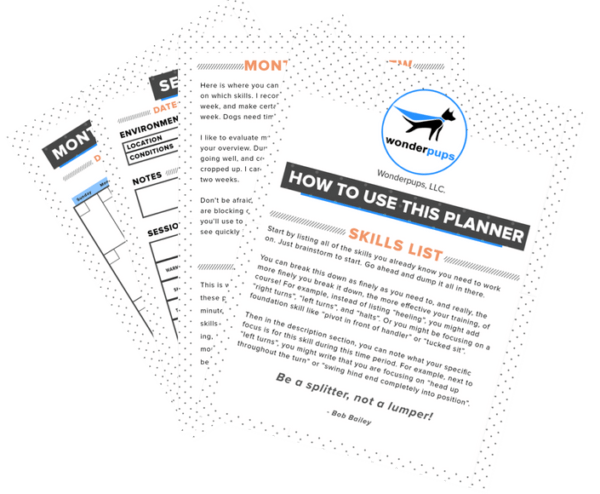Do you break into a sweat when you see this sign on a rally course? Out in the open, with not a single ring gate or wall near by?
Backing up in heel position is a challenging exercise for both dog and handler. We don’t always move too smoothly in reverse on our own, and adding a heeling dog to the picture increases the complexity significantly! So it’s extremely helpful to break up the skill of backing up from the complex behavior chain of “heeling” and teach that separately. We also want to make sure that our own movements and cues are helping, not hindering. Stepping on one’s own dog typically is not helpful in training happy and precise heeling! (I, of course, never step on my own dogs accidentally. Ever. Not even once.)
Before asking for my dog to step backward in heel position, I want to make sure he’s got a really solid understanding of the backing up action by itself. Check out my previous article on how I get that started. Once the dog is happily backing up on cue, and without the target, I’m ready to add it to heel position.
To do this, I’m going to bring the target back out as a way of temporarily reducing my criteria while we focus on the “next to me” component. When the dog is in heel position, the urge to sit or swing wide to look at the handler is even stronger. Having that target behind him reminds the dog to do something with back feet other than sit on them.
I’m going to set this training session up just like I did when I was initially teaching the skill. The only difference now is that I will be beside the dog, instead of in front of him. The structure of the session is the same, and I’ll be transferring my verbal cue to the movement of my left foot stepping back.
1. Set the dog up with his rear paws on the target as usual. Reinforce that, and then step around so that you are standing by the dog’s right shoulder (loosely heel position, but with no formality). Reinforce that several times. Since my dogs should sit if I stand in stationary heel position with my feet together, I’m going to make sure that I don’t provide that picture by standing with my feet apart.
2. Then, review the cue a few times. Clicking as the dog steps back onto the target, and reinforcing on the ground next to you.
3. Assuming that goes well, we’ll begin to transfer the foot movement. Take a careful and TINY step back with your left foot, and give the verbal cue to back up. Your right foot stays planted. Click and reinforce any effort the dog makes to go backward, and this time reinforce by your left leg… just as you would for heel positon. **Note: You’ll notice I’m barefoot in this video, and this is deliberate (not only because I can’t afford real shoes). Practicing barefoot helps me remember to take small steps and lets me feel more easily if I am about to step on my dog.
4. Next, start to present a more formal picture. Square off your shoulders, and hold your hands in your “home” position you use for heeling. If the dog steps back crookedly, missing the target, reset by targeting him back to your starting point. If you get two errors in a row, stop and review the back up to target exercise by itself.
5. Gradually add more steps back toward the target until you get a good 3-4 steps backward (You can keep going, of course. Don’t let me stop you.)
6. Finally, remove the target. This usually goes fairly quickly at this point, because you have transferred the behavior to different cues twice now: once to the verbal cue, and now again to the foot movement. Of course, in Rally, you can give both the verbal and the foot movement. But I like to train each separately, to give me a buffer for giving confusing or badly timed cues in the ring. (Also never, ever happens to me.)
A Few Helpful Tips:
- Remember in Rally, the judge is counting how many steps back you take (3), and not measuring the size of those steps. You will be better off taking 3 clear, but SMALL steps. Smaller steps reduces the risk of backing your dog into a wall or obstacle (never done that) and makes it easier for you to keep your balance, reducing the risk of wobbling and stepping on your dog (again, never done that).
- If, your dog is showing a tendency to drift behind you as he steps back, you may have a cuing problem and the cue for your left pivot is mixing with your back up. This is common, because we tend to look back over our left shoulder for both left pivots and backups, and the behaviors have a lot of overlap as well. Try looking down at your feet as you step back instead.
- For long term maintenance, vary the number of steps you take backward at any one time, making sure to reinforce a single step backward at least as frequently as you reinforce 3 or 4 steps back.
